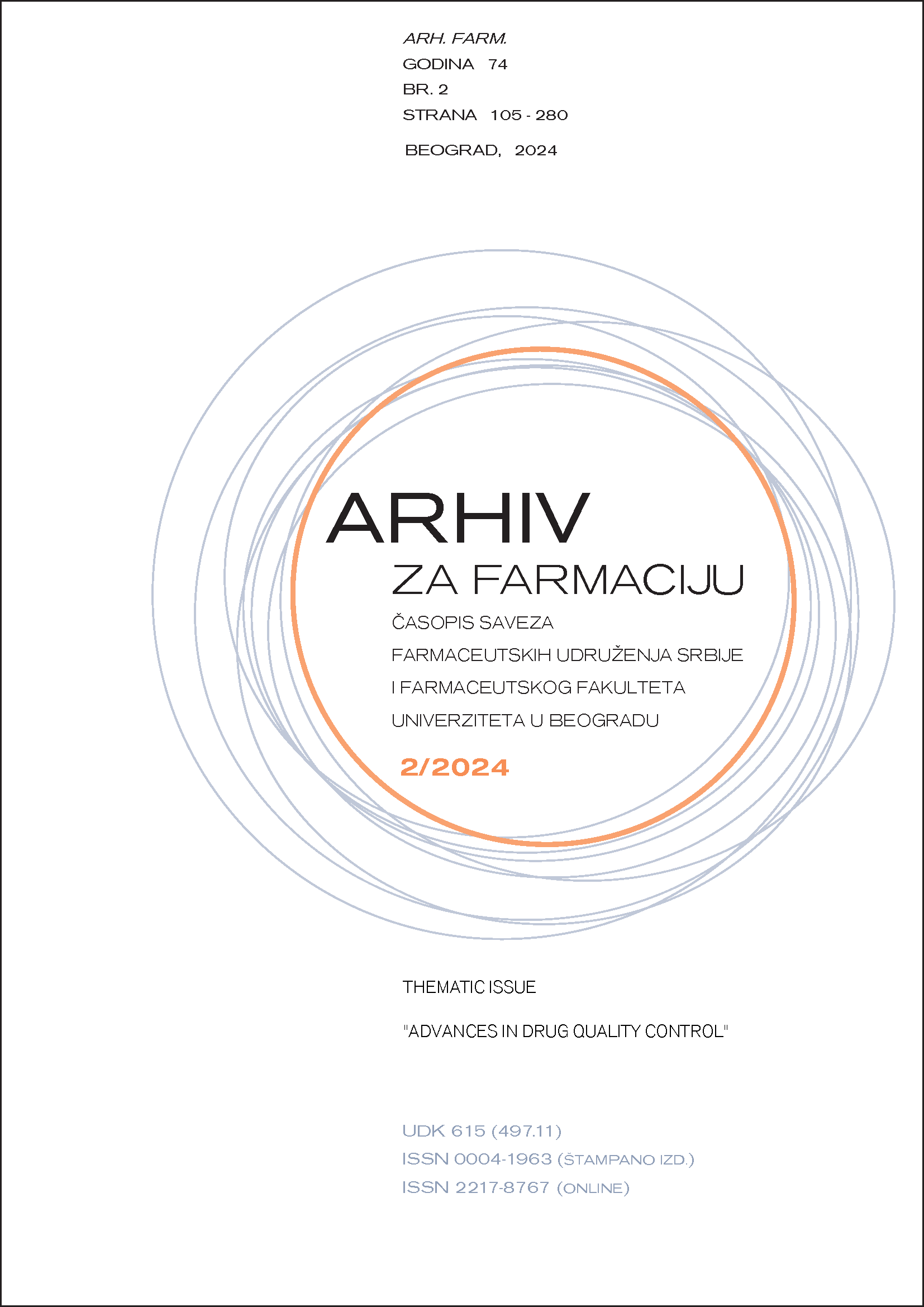PLS based quantitative determination of insulin aspart in solution using Raman spectroscopy
Abstract
The complex structure of medicines containing polypeptide active substances requires the implementation of challenging analytical approaches, based on physicochemical methods, and, where necessary, biological assays for quality control, as well as for the detection of substandard and falsified products. Vibrational spectroscopic techniques, including Raman spectroscopy, are fast, powerful, and non-destructive techniques which, when combined with multivariate chemometric modelling, can provide specific identification, quantitative determination, and insight into the secondary structure of proteins and peptides. The aim of this study was to investigate the possibility of using Raman spectroscopy as a screening method for quantification of pharmaceutical products containing active substances with polypeptide structures. For that purpose, a model based on partial least square (PLS) analysis for quantitative determination of insulin aspart in solution was developed using Raman spectroscopy. The proposed model enables the establishment of a rapid approach for screening of the quality of formulations containing active substances with polypeptide structure, providing the selection of suspected samples that should be further analysed using routine techniques, which are time-consuming and costly.
References
Wang L, Wang N, Zhang W, Cheng X, Yan Z, Shao G, et al. Therapeutic peptides: current applications and future directions. Sig Transduct Target Ther. 2022 Feb 14;7(1):1–27.
D’Addio SM, Bothe JR, Neri C, Walsh PL, Zhang J, Pierson E, et al. New and Evolving Techniques for the Characterization of Peptide Therapeutics. JPharmSci. 2016 Oct 1;105(10):2989–3006.
Vergote V, Burvenich C, Van de Wiele C, De Spiegeleer B. Quality specifications for peptide drugs: a regulatory-pharmaceutical approach. J Pept Sci. 2009;15(11):697–710.
Rastogi S, Shukla S, Kalaivani M, Singh GN. Peptide-based therapeutics: quality specifications, regulatory considerations, and prospects. Drug Discov Today. 2019 Jan 1;24(1):148–62.
Janvier S, De Spiegeleer B, Vanhee C, Deconinck E. Falsification of biotechnology drugs: current dangers and/or future disasters? J Pharm Biomed Anal. 2018 Nov 30;161:175–91.
Bakker-’t Hart IME, Ohana D, Venhuis BJ. Current challenges in the detection and analysis of falsified medicines. J Pharm Biomed Anal. 2021 Apr 15;197:113948.
Yang S, Zhang Q, Yang H, Shi H, Dong A, Wang L, et al. Progress in infrared spectroscopy as an efficient tool for predicting protein secondary structure. Int J Biol Macromol. 2022 May 1;206:175–87.
Delbeck S, Heise HM. Quality Assurance of Commercial Insulin Formulations: Novel Assay Using Infrared Spectroscopy. J Diabetes Sci Technol. 2021 Jul 1;15(4):865–73.
Ortiz C, Zhang D, Xie Y, Davisson VJ, Ben-Amotz D. Identification of insulin variants using Raman spectroscopy. Anal Biochem. 2004 Sep 15;332(2):245–52.
Jesus JIS da S de, Löbenberg R, Bou-Chacra NA. Raman Spectroscopy for Quantitative Analysis in the Pharmaceutical Industry. J Pharm Pharm Sci. 2020 Mar 2;23:24–46.
Durickovic I. Using Raman Spectroscopy for Characterization of Aqueous Media and Quantification of Species in Aqueous Solution. In: Applications of Molecular Spectroscopy to Current Research in the Chemical and Biological Sciences. IntechOpen. 2016. doi: 10.5772/64550.
Geskovski N, Stefkov G, Gigopulu O, Stefov S, Huck CW, Makreski P. Mid-infrared spectroscopy as process analytical technology tool for estimation of THC and CBD content in Cannabis flowers and extracts. Spectrochim Acta A Mol Biomol Spectrosc. 2021 Apr 15;251:119422.
Tuma R. Raman spectroscopy of proteins: from peptides to large assemblies. J Raman Spectrosc. 2005;36(4):307–19.
Ishigaki M, Morimoto K, Chatani E, Ozaki Y. Exploration of Insulin Amyloid Polymorphism Using Raman Spectroscopy and Imaging. Biophys J. 2020 Jun 16;118(12):2997–3007.
Dolui S, Roy A, Pal U, Kundu S, Pandit E, N Ratha B, et al. Raman Spectroscopic Insights of Phase-Separated Insulin Aggregates. ACS Phys Chem Au. 2024 Feb 15. doi: 10.1021/acsphyschemau.3c00065.

